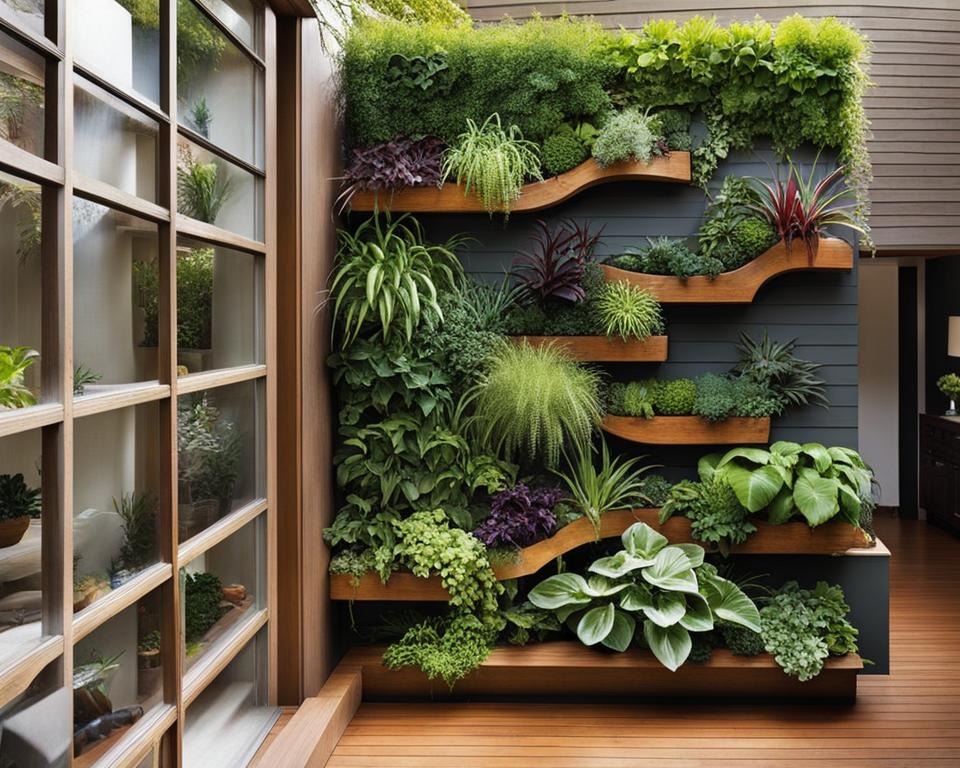As urban dwellers search for innovative ways to integrate nature into their living spaces, the popularity of vertical gardening has soared. Whether you’re a seasoned green thumb or freshly planting your roots in the world of horticulture, understanding the various types of vertical gardening, vertical gardening systems, and vertical garden designs can transform your approach to plant cultivation. These methods are not just a trend but rather a sustainable step towards creating verdant oases in space-constrained environments. Embrace the upward growth and discover how the art of vertical gardening can enhance both the aesthetics and functionality of any space, indoors or out.
Key Takeaways
- Vertical gardening allows for plant cultivation in limited spaces, making it perfect for urban living.
- There is a wide array of vertical gardening systems designed to suit different needs and aesthetic preferences.
- Vertical gardens can grow a diverse range of plants, from herbs and veggies to ornamentals.
- Innovative designs can be tailored not just for functionality but also to enhance space beauty.
- Understanding the basics of vertical garden structures is key to optimizing your gardening experience.
- Vertical gardening techniques cater to both novices and experts, offering versatility in gardening approaches.
Understanding Vertical Gardening and Its Origins
Delving into the roots of vertical gardening, one can uncover its rich historical lineage, a testament to human ingenuity in agriculture. This age-old practice, now refined with modern vertical gardening techniques, enables you to transform even the most compact spaces into verdant sanctuaries. Whether it’s integrating lush foliage on a balcony or crafting an edible wall of herbs and vegetables, the possibilities are boundless.
Throughout history, civilizations harnessed the benefits of vertical gardening to cultivate crops in challenging environments, enhancing both their survival and their surroundings. Today, these same principles apply but are tailored to the aesthetic and practical demands of contemporary life. With vertical gardens, you can exploit vertical real estate, reaping the rewards of fresh produce and vibrant flora without the luxury of a sprawling landscape.
- Space efficiency: Vertical gardens maximize limited urban spaces, allowing for lush greenery where ground space is scarce.
- Sunlight optimization: By arranging plants vertically, one ensures that they receive ample sunlight throughout the day, boosting their growth and vitality.
- Aesthetic enhancement: Beyond their utility, vertical gardens add an element of natural beauty to any setting, be it a modest apartment or a grand corporate foyer.
Employing vertical gardening techniques does not merely offer a solution to space constraints; it also provides a canvas for creative expression. Through the thoughtful selection of plants and strategic design, your vertical garden becomes a living artwork, ever-changing with the seasons. It’s a harmonious blend of form and function, resulting in a striking feature that breathes life into any environment.
With vertical gardening, you reap the physical and psychological benefits of nurturing a piece of nature, irrespective of the size limitations of your living space.
Embracing these ancient practices with contemporary approaches allows you to forge a personal connection with nature, cultivate your own food, and enrich your daily life with the unmatched beauty of a vertical garden.
Benefits of Vertical Gardening in Urban Environments
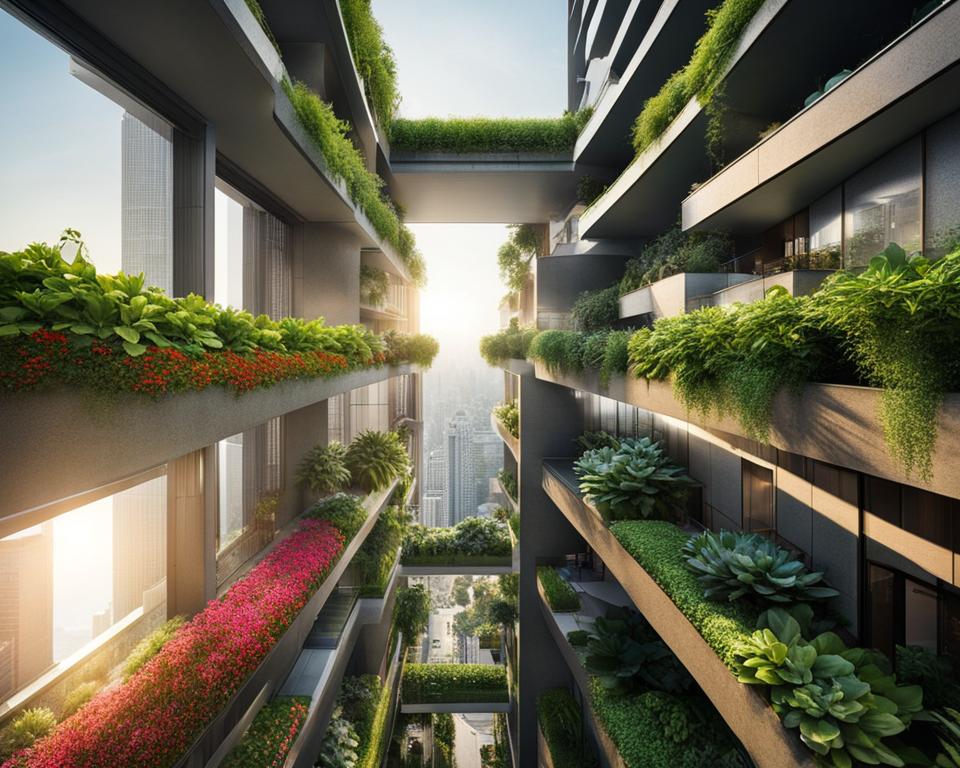
As an urban dweller, you may have encountered the challenge of wanting to cultivate a garden but finding that space is a premium commodity. This is where vertical gardening ideas come into play—a dynamic solution that transforms your small patios or balconies into lush, vertical vegetable gardens. By leveraging the unused vertical spaces, these gardens introduce a new dimension to urban agriculture and greenery.
Urban Garden maximization isn’t just about aesthetics; it also brings forth a host of environmental and social benefits. Imagine stepping out onto your balcony to find a thriving green wall that not only provides you with fresh produce but also acts as a natural air purifier and privacy screen. Indeed, vertical gardens are transforming the concrete jungle into a greener, more habitable environment for all.
- Maximize limited outdoor areas by growing upwards rather than outwards.
- Innovative designs for both edible and ornamental plants to create a living work of art.
- Healthier plant growth due to improved air circulation around the vertical structures.
Whether your choice leans towards ornamental beautification or the pragmatism of vertical vegetable gardening, urban gardens stand as a testament to human ingenuity in adapting to space constraints. Embrace the vertical perspective and let these innovative gardens elevate your urban living experience.
Discovering Creative Vertical Gardening Ideas
As you explore the world of DIY vertical gardening, you’ll find boundless opportunities to bring life and color into your home, regardless of its size. These inventive ideas for incorporating vertical gardening plants can transform your modest spaces into vibrant, verdant oases. Let us guide you through some ingenious concepts that can be easily adapted to your living area, encouraging you to take the leap into vertical gardening.
Adaptable Vertical Gardening for Small Spaces
Don’t let limited square footage dampen your green thumb aspirations. Ingenious vertical gardening solutions are specially designed for tight spots. By taking advantage of vertical space, you can create a miniature Eden. Think about repurposing hanging shoe organizers or crafting a trellis for cascading plants. The key is to select plant varieties that are suited for vertical growth, such as ferns, trailing vines, and compact vegetables like cherry tomatoes or strawberries.
Incorporating Vertical Elements into Balconies and Patios
Transform your balcony or patio into a lush retreat with some vertical gardening plants. A well-placed series of hanging planters can offer a cascade of greenery, while wall-mounted pots allow for a customizable palette of plants. For the DIY enthusiast, a simple pallet can be retrofitted into a standing garden for herbs and small flowers, providing both functionality and aesthetic appeal.
| Vertical Element | Benefits | Plant Recommendations |
|---|---|---|
| Hanging Planters | Space-efficient, portable | Petunias, Ferns, Spider Plants |
| Wall-Mounted Pots | Customizable, easy to maintain | Succulents, Ivy, Herbs |
| Standing Pallet Garden | DIY-friendly, versatile | Salad Greens, Edible Flowers, Strawberries |
| Trellises | Supports climbing plants, artistic | Clematis, Climbing Roses, Grapevine |
Incorporating these DIY vertical gardening techniques into your living space not only maximizes your area’s potential but also contributes to your well-being, with plants known to purify the air and elevate your mood. Start today and watch your vertical landscape flourish, bringing a touch of nature to your everyday life.
Designing for Vertical Growth: Choosing the Right Structures
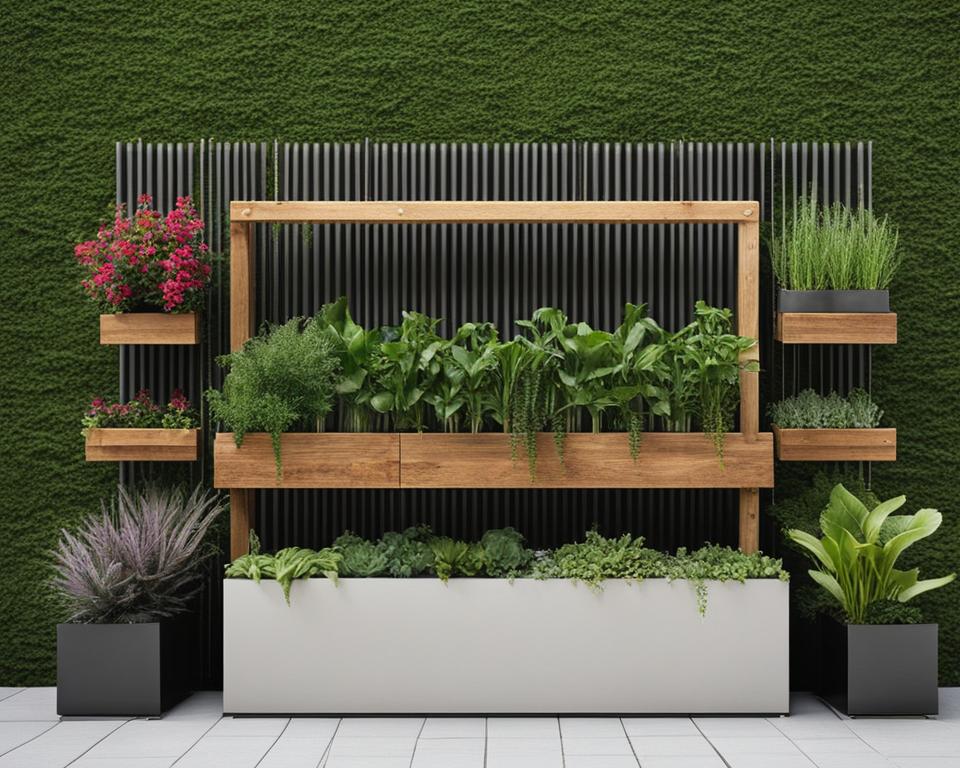
When you embark on your vertical gardening journey, selecting the suitable framework is just as critical as choosing the right plants. With the evolution of vertical garden designs, a variety of structures have become available to meet both functional needs and visual aspirations. Whether your aim is to cultivate a lush edible wall or a decorative green facade, the market offers options ranging from rudimentary supports to advanced, fully-integrated systems. Here are some vertical gardening tips to assist you in narrowing down the right structures for your vertical oasis.
Consider durability as a prime factor when making your selection—materials like cedar wood, powder-coated metal, and UV-resistant plastic will ensure longevity. For those who are sustainability-minded, reclaimed wood or bamboo may be of interest. The level of maintenance you’re willing to undertake can also influence your choice; while some systems require minimal upkeep, others might demand a more hands-on approach, especially if they include integrated irrigation or nutrition systems.
| Structure Type | Material | Durability | Maintenance Level |
|---|---|---|---|
| Basic Trellis | Wood/Bamboo | Medium-High | Low |
| Freestanding Vertical Planter | UV-resistant Plastic | High | Low-Medium |
| Hanging Pockets | Fabric/Recycled Materials | Medium | Medium-High |
| Metal Grid Panel | Galvanized Steel | Very High | Low |
| Integrated Wall System | Metal/Plastic with Irrigation | High | High |
Striving for a harmonious balance between aesthetics and practical functionality is key. The structure’s design should accentuate your space rather than clash with it. Whether you are drawn to the natural elegance of a green wall teeming with native ferns or the architectural precision of a geometric trellis supporting climbing vegetables, ensure that your choice reflects the spirit of your environment.
- Green walls: Architectural features that bring vibrancy to urban settings.
- Moss walls: Offer a touch of verdant tranquility indoors with minimal maintenance.
- Planter boxes with climbing frames: Ideal for small vegetables and flowering plants.
- Freestanding vertical garden units: Great for balcony or patio areas, and often moveable.
Embrace the vertical dimension in your horticultural designs; with thoughtful structure selection, your vertical garden will reach new heights of beauty and productivity. Remember, the best structures facilitate growth but also stand the test of time and the elements, all while enhancing the environment in which they live.
Type of Vertical Gardening: Exterior Walls and Facades
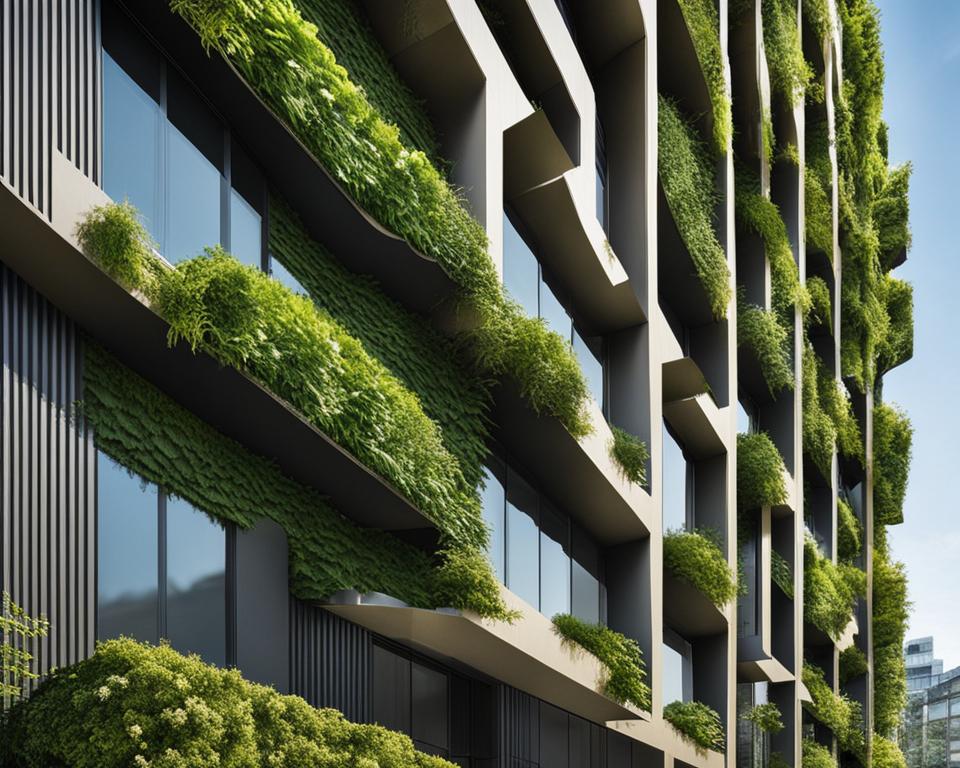
When you’re looking to breath life into urban settings, planting a vertical garden on exterior walls and facades can be both transformative and rewarding. The implementation of green walls as part of vertical garden designs can serve not only as a visual enhancement but also as an environmental boon, offsetting carbon footprints and invigorating biodiversity.
Selecting the Best Plants for Exterior Vertical Gardens
Selecting the right flora for your green walls can significantly influence their success and longevity. When planning your vertical garden designs, consider the endurance of plants to weather changes, their growth patterns, and the overall aesthetic they will impart upon maturation. Aim for a mix that balances foliage with flowering species to ensure year-round interest and vigor.
- Climbing vines like ivy or clematis, for robust coverage.
- Perennial herbs such as rosemary or thyme for aromatic appeal and practical uses.
- Evergreens to maintain a lush appearance even in colder months.
- Seasonal flowers to add bursts of color and attract pollinators.
Maintaining Outdoor Vertical Garden Systems
Proper upkeep is vital for the longevity of your outdoor vertical gardens. Implementing a maintenance schedule for watering, pruning, and nutrient application ensures that your vertical gardens remain vibrant and healthy. Automated irrigation systems can be a worthy investment for ease of care, and regular inspections will help in preventing potential issues like pests or disease.
| Task | Frequency | Seasonal Considerations |
|---|---|---|
| Watering | As required, depending on climate and plant needs | Adjust for rainfall and temperatures |
| Pruning | Biannual | Prune after blooming periods; prep plants for winter |
| Fertilization | Quarterly | Use a slow-release fertilizer in spring; minimize in fall |
| Pest control | As needed | More frequent checks in warmer months |
Type of Vertical Gardening: Container and Modular Options

As urban living spaces become increasingly compact, the ingenuity behind container vertical gardens and modular vertical gardening is more pertinent than ever. Not only do these methods elegantly conserve space, but they also introduce a dynamic element to modern living. Whether you’re looking to adorn your balcony or create a focal point in your living room, these versatile living wall systems seamlessly blend functionality with aesthetic appeal.
Integrating Living Walls into Home Decor
Imagine transforming a wall in your home into a lush, verdant oasis. Living walls not only serve as decorative elements but also as evolving eco-scapes that can shift and grow over time. The integration of a living wall system into your home decor doesn’t only stand as a statement piece; it’s a conversation starter, an evergreen backdrop that naturally refreshes the space it inhabits.
Exploring Eco-Friendly Green Wall Solutions
Green wall solutions take sustainability to new heights—literally. These vertical installations not only beautify spaces but also combat urban air pollution, offering improved air quality and additional insulation. Eco-friendly and innovative, these living wall systems contribute to increased biodiversity, creating habitats for a plethora of organisms even within concrete jungles. Modular designs provide a tapestry, woven not with threads, but with the vibrant textures of various plant species.
Ultimately, whether you opt for a simple set of container gardens or an elaborate modular system, you’re contributing to a greener, more sustainable environment. And with the flexibility to customize size, shape, and species, your green wall can become a personalized living work of art that flourishes alongside you.
DIY Vertical Gardening: Tips and Tricks for Starters
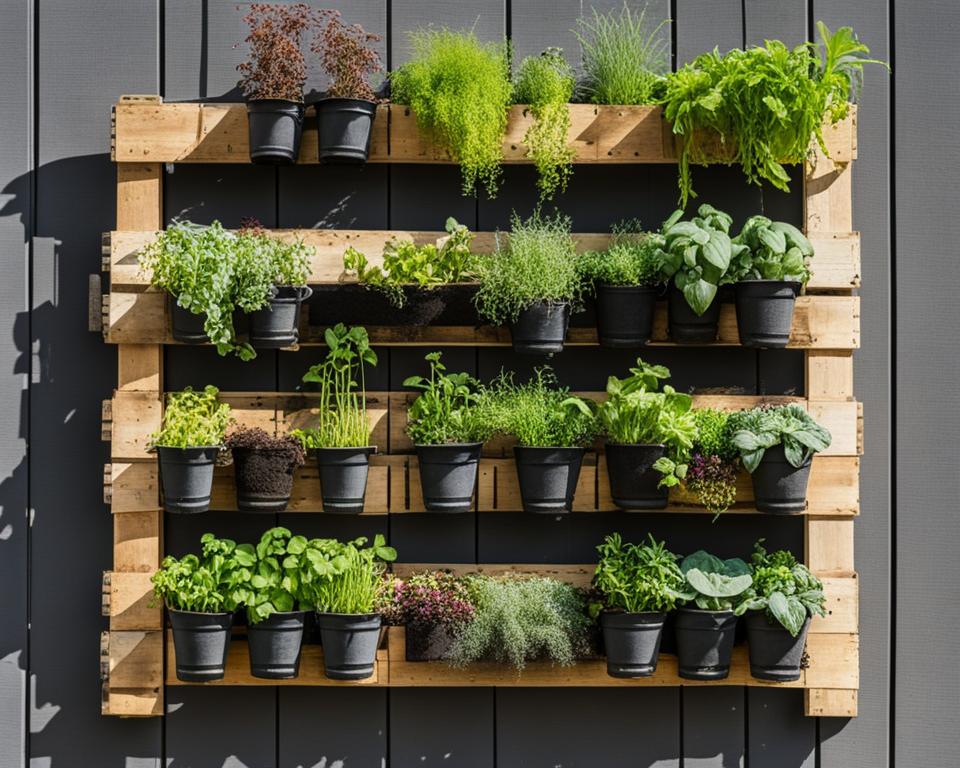
Welcome to the exciting world of DIY vertical gardening, where the sky is literally the limit! This form of gardening is perfect for those of you who are looking to maximize your growing space, add a touch of green to your living areas, or simply try out something new and fulfilling. Whether you have a sprawling backyard or a cozy apartment balcony, vertical gardening techniques are adaptable to virtually any space.
To get started, you’ll want to select some easy-to-maintain plants. If you’re new to gardening, herbs such as basil and mint or vegetables like lettuce and spinach are great because they are not only easy to care for but also give quick gratifying results. In selecting your structure, consider using common household items you might have lying around. Those old wooden pallets or plastic containers can be upcycled into beautiful and functional planters. Using sustainable materials not only saves you money but also contributes to an eco-friendly gardening practice.
When planning your DIY vertical garden, here are some useful tips to keep in mind:
- Ensure proper sunlight: Decide on a location that gets enough light for the plants you want to grow. Most edible plants require at least 6 hours of sunlight per day.
- Choose the right support: Make sure your vertical structure is sturdy enough to support the weight of the plants when they are fully grown. Consider the use of trellises, wall planters, or even a grid system.
- Think about water drainage: Good drainage is essential to prevent root rot. If you’re using containers, drill holes at the bottom. For pallet gardens, landscape fabric can help maintain soil and allow drainage.
Remember, the key to successful DIY vertical gardening is to start small and simple. As you gain confidence and experience, you can expand your garden and explore new plants and complex vertical gardening techniques.
Lastly, there’s no need to rush out and buy expensive products or systems. A wealth of tutorials and online resources are available to guide you through each step of your DIY vertical gardening project. With some creativity and patience, you’ll have a verdant vertical oasis that’s both a statement piece and a testament to your green thumb. Let’s dig in and watch your garden grow upwards!
Vertical Gardening Systems and How to Choose Them
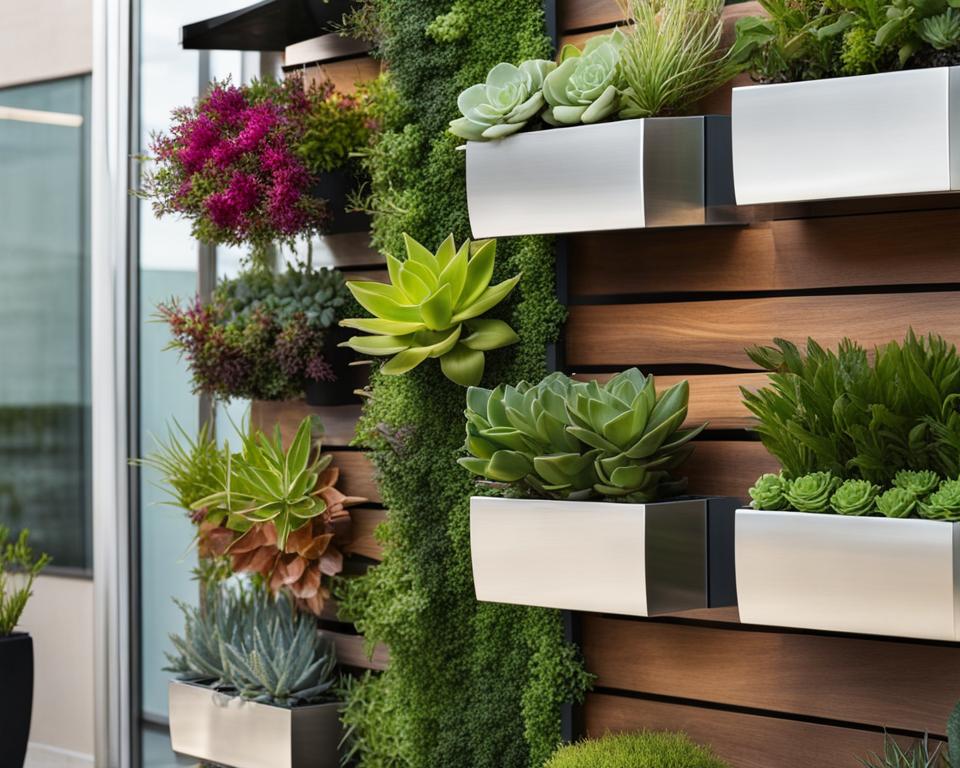
Embarking on the journey of vertical gardening requires selecting the right system that fits your space and botanical aspirations. Whether you lean towards the convenience of pre-built vertical garden structures or the customization possibilities of stirring together your own, assessing various factors is essential. Let’s explore what sets these systems apart and how to determine the best fit for your verdant vertical visions.
Comparing Pre-built Structures vs. Custom Solutions
The quest for the ideal vertical gardening system often leads to a fork in the road: choosing between pre-built structures or crafting a custom solution. Pre-built options, such as stackable planters and trellis kits, provide immediate gratification and ease of setup, ideal for those looking to dive straight into planting. On the other hand, custom solutions offer a tailor-made experience, designed to fit unique spaces or specific plant types.
Assessing the Cost and Material Durability of Systems
Fundamental to your choice of vertical gardening systems is considering both the financial investment and the longevity of the materials involved. Durability varies widely between different types of construction; plastic may offer affordability and lightweight properties, whereas galvanized steel stands up to the elements but at a higher price point. Below is a comparative table to aid in assessing some popular material choices.
| Material | Cost | Durability | Maintenance | Aesthetic Impact |
|---|---|---|---|---|
| Plastic | Low | Low-Medium | Low | Varies |
| Wood | Medium | Medium | High | Natural |
| Galvanized Steel | High | High | Low | Modern/Industrial |
| Fabric Pockets | Low | Low | Medium | Casual |
When considering aesthetics, envision how each material harmonizes with your current environment. Your vertical gardening system should not only support your plants but also enhance the space it occupies.
Remember, the best vertical gardening systems balance form with function. Your system should facilitate the growth of your plants while also fitting your budget and taste. Whether choosing pre-built vertical garden structures for their convenience or customizing a solution for a signature look, your green sanctuary awaits.
Types of Vertical Gardening: Indoor Vertical Gardens
Inviting the lush vibrancy of greenery into your living or working space has become more achievable with indoor vertical gardening. Not only is this approach a stylish visual feature, it’s a practical solution for those of us looking to efficiently utilize space while enriching our environment. Whether you’re looking to embellish a drab office wall or add a lively focal point to your living room, vertical gardens can serve as both ornamental and functional elements within indoor settings.
Maximizing Indoor Spaces with Vertical Gardens
With urban living spaces shrinking, the challenge of finding room for plants can be daunting. Vertical garden designs not only provide an answer to this problem but also transform walls into vibrant living art. Optimizing your space vertically means herbs, flowers, and even some vegetables can thrive right in your living area, kitchen, or home office. Indoor vertical gardens can vary from simple shelf arrangements to elegant and intricate installations that draw the eye and refresh the air.
Lighting and Irrigation for Healthy Indoor Plant Growth
Adequate lighting and proper hydration are essential for the health of your indoor vertical garden. The use of grow lights can provide your plants with suitable wavelengths to promote growth, mirroring the spectrum of natural sunlight. When it comes to watering, an easy-to-manage irrigation system, possibly even a self-watering one, can help maintain consistent moisture levels. Vertical gardening tips often suggest a balanced approach—combining technologies like timed drip irrigation systems with hands-on plant care—to ensure that your indoor garden flourishes.
Utilizing Vertical Vegetable Gardening for Fresh Produce
Have you considered the benefits of vertical gardening when it comes to harvesting your own fresh produce? Vertical vegetable gardening is not just an innovative and space-saving solution; it’s a transformative way to interact with your food. With a bit of creativity and some basic garden know-how, you can convert your balcony or indoor space into a verdant, vegetable-producing powerhouse.
Imagine picking fresh tomatoes, crisp lettuce, and fragrant herbs right from your living wall. This is the beauty of vertical vegetable gardening; it’s more than just a method to grow food—it’s a step towards sustainable living, right at your fingertips. The resilience of vertical gardens to pests and diseases means less chemical intervention, providing you with healthier, organic produce.
Let’s review some popular vegetables ideal for vertical gardening and assess their benefits. This comparison helps you choose the best crops for your vertical space and gives insight into why each is suitable for your vertical garden.
| Vegetable | Benefits for Vertical Gardening | Maintenance Level |
|---|---|---|
| Tomatoes | Can grow upwards with support, great space utilization | Medium |
| Cucumbers | Natural climbers, provide shade for lower growing plants | Medium |
| Peas | Love to climb, early season crop, fixes nitrogen in the soil | Low |
| Herbs (Basil, Mint, Parsley) | Compact growth, easy to harvest, aromatic vertical display | Low |
| Lettuce & Leafy Greens | Fast-growing, shallow roots, continuous harvest | Low |
As you gear up to start your vertical garden, remember that selecting the right vegetables is crucial. Those that can be trained to climb or do so naturally are perfect for vertical spaces, as they minimize the need for horizontal spreading. So, are you ready to embrace the art of vertical vegetable gardening? Not only does it open up a new dimension of gardening, but it also offers incredible benefits from a fresher diet to a greener living space—proving that sometimes, the best way to grow is up.
Vertical Gardening Plants: Picking the Right Flora
Embarking on the journey of vertical gardening requires a thoughtful selection of plants that align seamlessly with the vertical milieu. In choosing these plants, consider their adaptability to grow upwards and their ability to thrive when space is utilized in an unconventional manner. With the right species, your vertical garden can transform into a vibrant tapestry of greenery, flourishing under the care of innovative vertical gardening techniques.
Understanding Plant Requirements for Vertical Setups
As you venture into the realm of vertical gardening, acknowledging the different needs of plants becomes paramount. The vertical dimension introduces unique requirements such as distinct light exposure and varying gravitational effects on water flow. Succulents such as Sedum or Echeveria exhibit resilience in higher, sun-bathed areas, while lush ferns prefer the shade and moisture that lower positions may offer.
Creative Plant Pairings for Aesthetic and Functional Gardens
Melding form with function, creative plant pairings go beyond mere visual pleasure in vertical gardening. Combining edibles with ornamentals, such as pairing fragrant lavender alongside robustly vertical rosemary herbs, provides a sensory feast while optimizing space. The use of vertical gardening plants is an exploration of symbiotic relationships–whereby certain plants, when paired together, can actually improve each other’s health and vitality.
- Sedum – A drought-tolerant succulent which thrives in full sun conditions
- Ferns – Shade-loving plants that add lushness to the garden’s lower tiers
- Lavender – With its pleasant fragrance, it attracts pollinators and repels pests
- Rosemary – An aromatic herb that grows well vertically and provides height to plant arrangements
By understanding the characteristics of each species, including water needs, light preferences, and growth habits, your vertical gardening endeavors will not only flourish but also bring a tailored beauty to your living space.
Conclusion
As we have explored, vertical gardening is an incredibly adaptable form of cultivation that opens up a myriad of possibilities for the creative grower. Regardless of the space at your disposal or your experience level, there is a type of vertical gardening that can seamlessly integrate into your lifestyle. For those with a penchant for home projects, DIY vertical gardening offers a rewarding challenge, as you transform ordinary materials into thriving green spaces.
The elegance of vertical garden designs also lies in their diversity and adaptability. Your vertical garden can be as simple as repurposed bottle planters on a sunny kitchen window or as intricate as a professionally installed green wall, inviting nature’s resilience and vitality into urban environments. Whether your goal is to cultivate fresh herbs within arm’s reach or to create a breathtaking living wall of diverse plant species, your vertical garden embodies an innovative spirit that reshapes the concept of gardening in the modern era.
In essence, vertical gardening is more than just a trend; it’s a sustainable, space-efficient, and aesthetically appealing approach to reconnecting with nature. Consider the array of vertical gardening ideas at your disposal, and begin the delightful journey of transforming your available space into a lush vertical oasis. By selecting the right techniques, systems, and plants, you will be able to embark on a personalized venture into the world of vertical gardening, yielding not only an abundance of plants but also the intrinsic reward of nurturing life in harmony with your surroundings.
FAQ
What are the different types of vertical gardening systems?
There are various types of vertical gardening systems including trellises, green walls, stackable planters, hanging baskets, tower gardens, and modular panel systems. Each offers different advantages suited for either indoor or outdoor gardening, and can range from simple DIY setups to more sophisticated, pre-built structures.
Can you explain the benefits of vertical gardening?
Vertical gardening optimizes limited space, especially in urban environments, by utilizing vertical surfaces. Benefits include increased planting area, enhanced accessibility and maintenance, improved air quality, greater biodiversity, aesthetic appeal, and the potential for thermal insulation of buildings when outdoor walls are used for planting.
How is vertical gardening suitable for urban gardens?
In densely populated urban areas, vertical gardens make excellent use of small balconies, patios, and indoor spaces for growing plants. They can transform underutilized vertical spaces into productive, green environments – perfect for growing vegetables, herbs or ornamentals, while also contributing to the well-being of city residents.
Can you provide some creative vertical gardening ideas?
Creativity in vertical gardening can manifest in using upcycled materials like pallets and plastic bottles as planters, installing vertical planters on walls or fences, incorporating hanging planters, or creating tiered plant shelves to maximize growing space. The use of trellises and arbors can also add a vertical dimension to gardens for climbing plants.
What should be considered when choosing structures for vertical gardening?
When selecting structures for vertical gardening, consider the weight load, durability, and material of the structure, as well as how it will integrate with the design of your space. Additionally, look at the maintenance requirements, ease of installation, and whether the structure will support the types of plants you intend to grow.
What are the best plants for exterior vertical gardens?
For exterior vertical gardens, choose plants that are resilient and can withstand the specific climate conditions of your area. Climbing plants like ivy, jasmine, and climbing roses, as well as perennials like ferns and certain types of grasses, are often good choices for outdoor vertical garden structures.
How can I maintain outdoor vertical garden systems?
Maintenance of outdoor vertical garden systems includes regular watering, pruning, fertilizing, pest control, and ensuring that plants receive adequate sunlight. It is crucial to routinely check the structural integrity and irrigation systems to ensure the long-term health and success of the garden.
What are some container and modular vertical gardening options?
Container and modular vertical gardening options include wall planters, fabric pocket planters, stacked pots, and modular planting panels. These systems can be freestanding or wall-mounted, and they often come with built-in irrigation systems, making them convenient and versatile for a variety of spaces.
How can living walls be integrated into home decor?
Living walls can be integrated into home decor as focal points in living rooms, kitchens, or home offices. They function as dynamic art pieces that can be customized with a variety of plants to complement the design and color scheme of the room. They also improve air quality and add a touch of nature to indoor spaces.
What are the benefits of green wall solutions?
Green wall solutions offer environmental benefits like improved air quality, noise reduction, and increased biodiversity. They can also provide thermal insulation for buildings and create peaceful, natural spaces in urban environments. Additionally, green walls can reduce stress and boost mood, contributing to overall well-being.
What are some useful tips for beginners interested in DIY vertical gardening?
Beginners should start with simple, low-maintenance plants and straightforward vertical structures. Research and follow step-by-step guides or tutorials to create your own vertical gardening projects. Experiment with different designs and learn from each experience to continually improve your vertical gardening skills.
How do pre-built structures compare to custom vertical gardening solutions?
Pre-built structures are convenient and typically easy to install, suitable for standard gardening needs. Custom solutions, however, can be tailored to fit specific space requirements and aesthetic preferences, offering greater flexibility and often higher durability if designed and built with care.
When assessing vertical gardening systems, what considerations should be made regarding cost and material durability?
Evaluate the initial cost of the system, the long-term maintenance expenses, and the expected lifespan of the materials. Popular materials like plastics and metals such as aluminum or galvanized steel vary in terms of durability, cost, and suitability for different climates and indoor/outdoor use.
How can I maximize indoor spaces with vertical gardens?
Maximize indoor spaces by utilizing wall-mounted planters, hanging baskets, and freestanding vertical units. Choose locations that receive sufficient natural light or supplement with grow lights. Use space-efficient plants and vertical structures that fit well with the interior design and available room.
What are some lighting and irrigation tips for healthy indoor plant growth?
Ensure that plants receive enough light—either from natural sources or artificial grow lights—appropriate for their species. Use self-watering planters or drip irrigation systems for consistent moisture, and monitor humidity levels to avoid mold growth and ensure a healthy plant environment.
How can vertical vegetable gardening benefit those with limited space?
Vertical vegetable gardening allows the cultivation of a variety of vegetables in a condensed area, turning even a small balcony into a productive space. This approach saves floor space, reduces weeds, improves accessibility for maintenance, and can enhance the aesthetic enjoyment of the gardening experience.
What should I consider when selecting plants for my vertical garden?
Consider the light, water, and soil requirements of each plant, as well as its mature size and growth habit. Plants that do well in vertical gardens often have shallow root systems and are relatively low maintenance. Mixing plant types for varied colors, textures, and heights can also create an attractive display.
How can creative plant pairings improve my vertical garden?
Creative plant pairings can enhance visual interest and take advantage of complementary growth patterns. For instance, combining plants with different foliage textures and colors can create a captivating visual tapestry, while pairing fast growers with slower ones can ensure consistent coverage and interest throughout the growing season.

